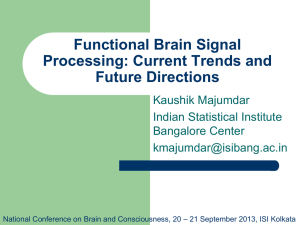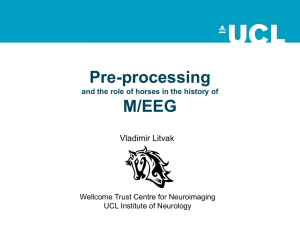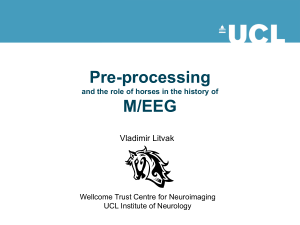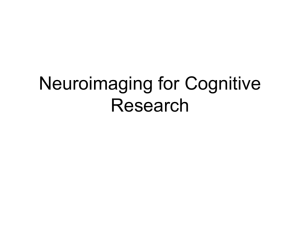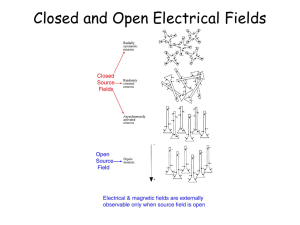Presentation 1 - Translational Neuromodeling Unit
advertisement
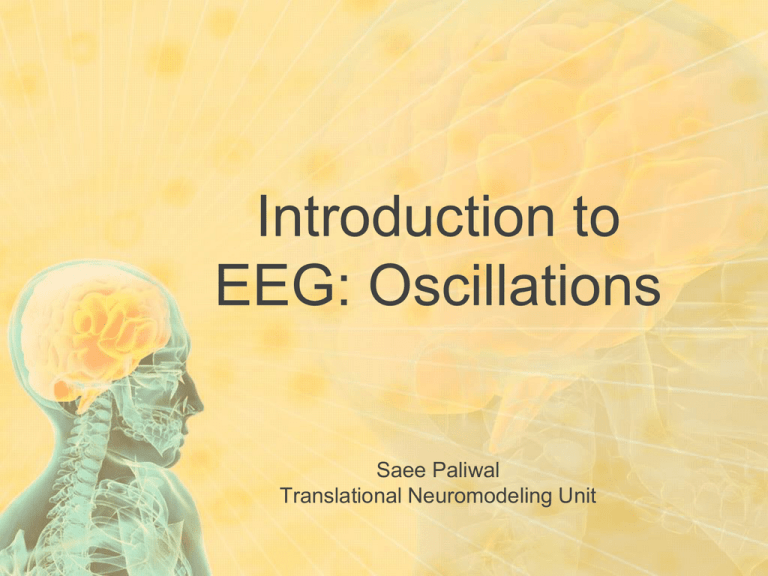
Introduction to EEG: Oscillations Saee Paliwal Translational Neuromodeling Unit Overview Background History of EEG Measurement techniques What is an EEG? Components of an EEG Sample healthy data Patient data Oscillations and Synchrony Characteristics of brain oscillations Oscillations and synchrony The function of oscillations Interesting applications Phasic artificial neural networks A brief history of the electroencephalogram (EEG) 1875: English physician Richard Caton observes EEG from the exposed brains of rabbits and monkeys. 1924: German Neurologist Hans Berger uses radio equipment to amplify electrical activity measured from the human scalp. He also coins the term electroencephalogram. 1934: Adrian and Matthews published the paper verifying concept of “human brain waves” and identified regular oscillations around 10 to 12 Hz which they termed “alpha rhythm” Bronzino, 1995 Modern Implementation Electrode placement for a 10-20 electrode EEG looks as follows: Two modes of recording--Differential and Referential: Differential: two inputs to each differential amplifier are from two electrodes Referential: one or two reference electrodes are used What is EEG? A medical imaging technique that reads scalp electrical activity generated by brain structures. The EEG itself is defined as “electrical activity of an alternating type recorded from the scalp surface after being picked up by metal electrodes and conductive media” (Niedermeyer et al, 1993) How does this work? When the brain is activated, local current flows are produced EEG measures currents that flow during the dendritic activity of cortical pyramidal neurons. The electric potentials are a result of are a result of graded potentials from pyramidal cells creating electrical dipoles between the soma and apical dendrites. Current is read non-invasively through the skin, skull, etc. Signals are amplified and normalized during post- Components of an EEG Brain waves are sinusoidal, generally in the range of 0.5 to 100 μV in amplitude Through Fourier transforms on the brain signal, a power spectrum from the raw EEG signal is derived. Brain waves have been categorized into four basic groups beta (>13 Hz) alpha (8-13 Hz) theta (4-8 Hz) delta (0.5-4 Hz). Alpha and Beta waves Alpha Frequency: 8–13 Hz Location: Posterior half of the head and are usually found over the occipital region of the brain. Interpretation: Indicate both a relaxed awareness, may be is nothing but a waiting or scanning pattern produced by the visual regions of the brain. Eliminated by opening the eyes, by hearing unfamiliar sounds, by anxiety, or mental concentration or attention. Beta Frequency: 14–26 Hz Location: the frontal and central regions Interpretation: Associated with active thinking, active attention, focus on the outside world, or solving concrete problems, and is found in normal adults. A high-level beta wave may be acquired when a human is in a panic state. Delta and Theta waves Delta Frequency: 0.5–4 Hz. Location: Cortex or thalamus Interpretation: Associated with deep stage 3 of slow-wave sleep and help characterize the depth of sleep. Theta Frequency: 4–7.5 Hz. Location: Thalamus, Hippocampus, cortex Interpretation: Two types: type 1 associated with voluntary behavior and during REM sleep, and type 2 appears during immobility and anasthesia. A theta wave is often accompanied by other frequencies and seems to be related to the level of arousal. Larger contingents of theta wave activity in the waking adult are abnormal and are caused by various pathological problems. Data Example EEG recording, 10 channels Dementia EEG recording of a patient with Creutzfeldt–Jakob diseases (CJD). CJD is characterized with aphasia, apraxia, and agnosia, and can be diagnosed using EEG signals. One sees a slowing of the delta and theta wave activities and, after approximately three months of the onset of the disease, periodic sharp wave complexes are generated that occur almost every second, together with a decrease in the background activity Epilepsy Example EEG recording of a patient with epilepsy. Onset of a clinical seizure characterized by a sudden change of frequency in the EEG, in the alpha wave frequency band with a slow decrease in frequency (but increase in amplitude) during the seizure period. It may or may not be spiky in shape. Bursts of higher frequencies can be seen in sections of the EEG. (a) seizure activity mal seizure (b) grand What exactly are we measuring? The beating brain The mechanism: The fundaments of the EEG signal lie in in the following mechanism: Brain cells are activated and local current flows are produced EEG measures the currents that flow during synaptic excitations of dendrites of pyramidal neurons in cortex. Large populations of neurons generate EEG-readable activity Some characteristics: The data itself is continuous and periodic. Even a single neuron can oscillate! Neighboring frequency are associated with different brain states and compete each other, but several rhythms can coexist at the same time. The power of the beat The power density of EEG inversely proportional to frequency (f ). Perturbations in the slower frequencies can cause a cascade of energy dissipation at higher frequencies—the slower waves are the moderators. Properties of neuronal oscillators are incumbent on the physical architecture of neuronal networks, and are limited by the speed of neuronal communication (axon conduction and synaptic delays) The period of neuronal oscillations is constrained by the size of the neuronal pool involved in the signal (smaller pools generate higher frequencies) Oscillations and Synchrony Integration of information requires “synchrony” across different neural populations Synchrony is defined by the temporal window within which some trace of an earlier event is retained, which then alters the response to a subsequent event. Successive events that evoke identical responses are deemed nonsynchronous. Large scale neuronal oscillators behave like relaxation oscillators—their activity is phase dependent, so the “duty cycle” of the oscillator is separated from the receiving phase, and can synchronize robustly. The function of oscillations part 1 Input selection and plasticity: The neuronal (single or assembly) response to a strong input is an oscillation, the frequency of which is a function of two things: the leak conductance and capacitance of the neuronal membrane (responsible for low-pass filtering) and the voltage-gated currents (high-pass filtering). This makes the neuron a band-pass filter! These resonant frequencies allow neurons to select inputs based on their frequency characteristics and set network dynamics. Binding cell assemblies: Information in the brain thought to be stored in distributed, flexible pools of neurons Oscillatory synchrony could bind them—cost effective (unlike chemical synaptic change) As long as the frequencies of the coupled oscillators remain similar, synchrony can be sustained even with very weak synaptic links So basically, activated neuronal groups in distant cortical The function of oscillations part 2 Consolidation and combination of learned information: The resting state of the brain consists of self-governed oscillations (particularly of thalamocortical loops) These oscillations represent information acquired during the day. This replay of information learned allows for “compiling” Representation by phase information: For any oscillator, the coupling strength is proportional to the magnitude of phase shift (phase advancement). Exploiting this property allows for rapid, short-term storage in the forward phase shift of action Oscillators can exploit STDP through several temporal iterations of a pattern—this kind of learning disappears when theta waves are disrupted. An interesting application… Synchrony in ANNs Artificial Neural Networks benefit from synchrony Reichart et al, 2014 proposed a novel approach to Deep Learning—neural networks with phase synchrony Essentially, he added a phase component to the transfer function The most striking result is that he was able to disentangle overlapping images, demonstrating the idea that each image concept was stored in phasic information Thank you!! Questions? References J. D. Bronzino. 1995. Principles of Electroencephalography. In: J.D. Bronzino ed. The Biomedical Engeneering Handbook, pp. 201-212, CRC Press, Florida. Schnitzler A, Gross J (2005) Normal and pathological oscillatory communication in the brain. Nat Rev Neuro 6: 285–296. Schyns PG, Thut G, Gross J (2011) Cracking the Code of Oscillatory Activity. PLoS Biol 9(5): e1001064. doi:10.1371/journal.pbio.1001064 E. Niedermeyer, F. H. Lopes da Silva. 1993. Electroencephalography: Basic principles, clinical applications and related fields, 3rd edition, Lippincott, Williams & Wilkins, Philadelphia. Reichert, David P., and Thomas Serre. "Neuronal Synchrony in Complex-Valued Deep Networks." arXiv preprint arXiv:1312.6115 (2013). Buzsáki, György, and Andreas Draguhn. "Neuronal oscillations in cortical networks." Science 304.5679 (2004): 1926-1929. Buzsaki, Gyorgy. Rhythms of the Brain. Oxford University Press, 2006.

